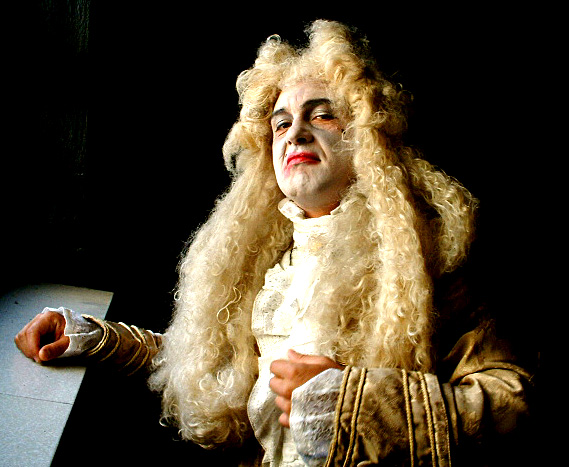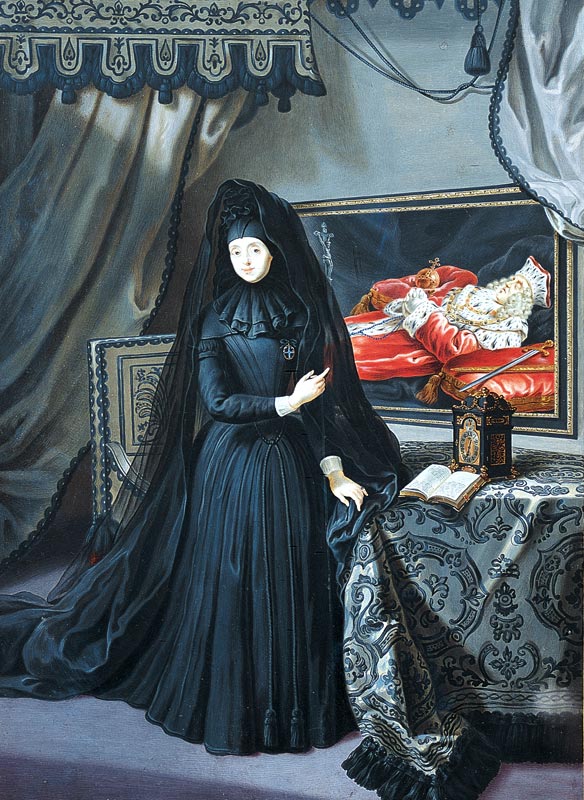I haven’t been watching The Borgias — I got so ticked off at the inaccuracy of The Tudors (it wasn’t the king of Portugal that Mary (not Margaret — she married James IV of Scotland), screwed to death, it was the king of France, for crying out loud) that I quit watching Heaving Bosom Sagas altogether. But I have to admit that the Medicis are fertile ground for this type of show, especially the last of the Medici Grand Dukes, Gian Gastone, though in his case, it wasn’t bosoms that were heaving.
The Medici were a wool-trading family from the Tuscan countryside that rose to social and political prominence via well-chosen marriages until about 1400 when they got involved in an ill-chosen political plot and were mostly exiled from Florence. The one Medici who remained had a son who started a bank and, then as now, banking is the way to wealth and power. The Medici claimed to be no more than prominent citizens even as they ruled over Florence. There was a series of great Medici leaders who patronized artists including Leonardo, Bruneschelli, Machiavelli, and Botticelli. After about a century of this, the family formalized their rule and a Medici became Duke in 1532. That wasn’t really much of a thing at the time; far more important was that two 16th Century popes were Medici since Florence was effectively ruled by the papacy at the time.
Marriage continued to be an important route for advancing the family fortunes and, by the mid-17th Century, there were Medici relations on many thrones, including both France and Spain. Cosimo II sponsored Galileo but when he died, rule passed to his widow and his grandmother, regents for Cosimo’s young son. They were staunch Catholics and allowed the astronomer to be tried as a heretic. Cosimo’s son, Fernando, was a bit more forward-thinking than his regents but, after taking the throne, involved Florence in a nasty little war that wound up bankrupting the city. His son, Cosimo III, ascended the throne in 1670. There was nothing forward-thinking about this Medici and his rule is marked by vicious anti-Jewish policies, harsh taxation, and the decline of a once-great city.
Cosimo III had an unhappy marriage — nothing unusual about that, the Medicis almost never had happy marriages — but it wasn’t quite poisonous enough to prevent the couple from producing three children. Eventually the royal couple split though, and the Grand Duchess went to live in Louis XIV’s France. The eldest of the three Medici children died in 1713 leaving Anna Maria Luisa (or Ludovica) and Gian Gastone as potential heirs. Anna Maria Luisa married the Palatine Elector. He had syphillis and the marriage was childless (though surprisingly happy for a Medici union). Gian was little interested in either marriage or ruling Tuscany. He studied natural sciences and enjoyed being left to the contemplation of plants and insects. Alas, he was not to be allowed to enjoy himself.
Cosimo enlisted his daughter’s help in arranging a marriage for Gian with Anna Maria Franziska of Saxe-Lauenburg. It is simply not enough to say that this was an unhappy marriage; it was an emotional disaster with the royal couple despising one another. She demanded to live in Germany, he wanted to live in Italy. Or France. Or Prague. Or anywhere other than the country retreat favored by his wife. There were no children. Anna Maria Franziska said that Gian was “completely impotent”. Eventually, Cosimo III became reconciled to the fact that he could not turn his son into a monarch. On his deathbed in 1713, he tried to arrange for Anna Maria Luisa to succeed him, but the succession was a political question for other, stronger European states, who blocked her from the throne.
Gian never forgave his sister’s interference in his life and did whatever he could to annoy her. As Grand Duke, Gian repealed his father’s nastiest legislation — there was no more official anti-semitism, no more public executions, no more outrageous taxes. This did annoy Anna Maria Luisa, who was cut from the same reactionary cloth as her father, but Florentines loved their new ruler. Even though the city was sunk in poverty, with a population of fewer than 50,000 and grass growing in the streets, it was a happier place then it had been since the death of Cosimo II, more than forty years before.
Happy Florence might be, but Gian was profoundly unhappy. He was given to fits of weeping and bouts of drinking. He surrounded himself with young men who appealed to him. These were called ruspanti, a word which is derived from the name of a worthless coin and connotes something like “free ranging“. So Gian gave himself over to cavorting with his chickens. He spent most of his time in bed, either with ruspanti or a bottle or both.
One person that Gian liked was his widowed sister-in-law, Violante, who he made governor of Siena. She, on the other hand, did not get along with Anna Maria Luisa, who in turn, never saw much of her brother during the years they shared a palace. Eventually, though, Violante and Anna Maria Luisa colluded on a program meant to improve Gian Gastone’s reputation. This had become a serious matter, with other states talking openly about solving the “Tuscan problem”. The two women set up public events that Gian was inveigled to attend, although he hated such affairs. This did not go well: Gian Gastone’s “behavior at these [banquets] literally sent guests running for their carriages: he vomited into his napkin, wiped his mouth with his peri-wig and told rude jokes.”
In 1729, Gian had not been seen in public for so long that people thought he was dead. Anna Maria Luisa arranged a great celebration on the feast day of St. John the Baptist so that her brother might be seen to be alive. Gian arrived at the party totally drunk and vomited throughout the proceedings. Eventually he passed out and was carried away in a litter. A month or two later, Gian sprained his ankle and used this as an excuse to stay in bed for the rest of his life.

Gian Gastone as portrayed in a recent Italian drama. [http://www.porpore.com/numero7/coniluce2_n7.html]
Gian Gastone was quite unhappy with all this but by now he was dying and unable to do anything about it. Anna Maria Luisa was, once again, barred from inheriting. She was bitter, but determined to maintain her dignity. She spent her last years working on finishing the family tomb.
One of the last acts of the Medicis was to make certain that the royal possessions belonged to the family and not to the throne. So it was that Anna Maria Luisa, last of the House of Medici, was able to leave the family’s massive collection of art treasures to Tuscany, on condition that it never leave Florence. The Uffizi and Pitti Galleries today are testament to the value of that legacy.
Notes:
The Esoteric Curiosa has done several Medici articles including reprinting chapters from G.F. Young, The Medicis. Here’s Young on Anna Maria Luisa/Ludovica.
And the excellent Esoteric Curiosa essay on Gian Gastone.
Brian Sewell talks about Gian Gastone from the Medici Palace.





Very interesting. My husband’s ancestors connect to this family. You have inspired me to search more for the connection. Thanks!